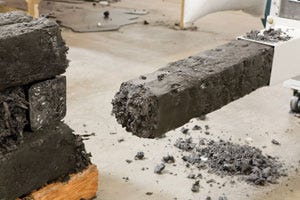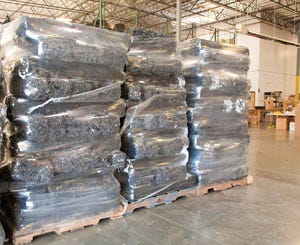Foam packaging: Compacting improves recyclability
January 29, 2014


Compacting improves foam recyclability
Cases Plus Inc., a Lincoln, CA, wholesale distributor of industrial shipping cases that it customizes for applications in electronics, aerospace and the military, faced a dilemma. The company wanted to recycle the PE foam scrap it generates from the foam cushioning inserts it makes to line the inside of the cases. But recycling the foam scrap had to be done cost-effectively.All of its carrying cases and shipping rack-mounted containers are designed to protect delicate and fragile equipment, including plasma screens, military systems, audio/video/broadcast equipment, camcorders, laptops, computer hardware and more. Cases Plus relies on two high-end pieces of equipment to create precision inserts from PE foam plank: A water-jet unit; and a die-less knife system.
endly and cost-effective way to do the job.

Compacting improves foam recyclability
According to CEO Jean-Claude Avenel, finding a way to recycle the foam scrap wasn't as easy as it sounds. “The significant amount of scrap we were generating from our fabrication process made it necessary to haul a 16-cubic-yard trailer to a landfill twice a day,” he says. “Not only did that use up approximately four man hours a day, there were fuel and landfill charges.” The company turned to its PE foam supplier, Pregis Corp. for help finding an environmentally-fri
“Recycling foam plank has been an issue in many geographic locations because shipping scrap can often cost more than the value of the load,” points out Tony Smith, general manager, engineered products, at Pregis. “Without an economic incentive to recycle, scrap frequently ends up in landfills.”
With most foam planks sized at about 48x8 in., fabricators use a variety of methods to cut appropriately sized pieces and shapes to protect and cushion their products. What ends up being discarded are leftover outer edges and small bits and pieces. “When you multiply that scrap by 200 or 300 planks per day, it becomes sizeable,” Smith says.

Compacting improves foam recyclability
To help fabricators manage the leftover pieces environmentally, Pregis has introduced the Densinator™ compactor, a unit which includes a foam shredder, that shreds and condenses foam scrap fed into its hopper, using a light heating process. While it sounds like it could be the name of an Arnold Schwarzenegger movie, the Densinator compresses the foam leftovers to 1/15th of their original size. The end result is an HDPE log that measures 6x6x48 in. The foam log has a thin, rigid outer shell that helps maintain the log's compact brick shape.“The outer surface of the brick or log is heated, creating the thin, rigid shell that maintains the brick shape,” Avenel explains. Cases Plus loads the logs on pallets (roughly 2,000 lb/pallet) and ships the loads back to Pregis each month so that the logs can be used as recycled content for the
Compacting improves foam recyclability
production of future foam plank. The shell keeps dust and debris to a minimum.Keeps more foam scrap out of landfills
Cases Plus added the Densinator to its operation in August 2009. “It took less than a day to install,” Avenel recalls. “We estimate that we will end up preventing 40,000 pounds [or 20 pallet loads of used foam] from entering landfills every month,” he adds. “We are now getting paid for the reclaimed material, which ends up paying for the cost of the Densinator. We save about three hours a day in labor and about $1,000 a month in disposal costs. And we only need an hour a day to run the Densinator instead of the four hours we previously needed to haul scrap to the landfill. We're absolutely pleased with this system.”

Compacting improves foam recyclability
More logs per load

Compacting improves foam recyclability
Space-saving and easy to operate, the compactor measures 104 in. long, 62 in. wide and 102 in. high. It handles both clean and dirty PE foam and the loads need no strapping. The logs can be fed directly into most plastic-reclaiming systems, according to Pregis.
“You can load 30,000 to 35,000 pounds of logs onto a 40-foot tractor trailer compared to only 2,000 pounds of foam in an uncompressed state,” Smith says. The Densinator can also reduce fees for landfills, bin rentals and hauling.
The machine is easy to load by a single operator. Smith says the logs can be reclaimed and put back into foam production or be sent to fabricators that manufacture products such as carpeting, composite wood and much more.

Compacting improves foam recyclability
More information is available: |
Pregis Corp., 800/834-9441. www.pregis.com |
About the Author(s)
You May Also Like


